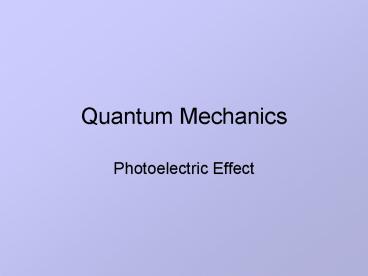Quantum Mechanics - PowerPoint PPT Presentation
1 / 8
Title:
Quantum Mechanics
Description:
Explain the failure of classical wave theory to explain the observations ... Millikan spent a decade perfecting an experiment to disprove Einstein's ... – PowerPoint PPT presentation
Number of Views:1039
Avg rating:3.0/5.0
Title: Quantum Mechanics
1
Quantum Mechanics
- Photoelectric Effect
2
Lesson Aims
- State the main observations of Millikans
experiment - Explain the failure of classical wave theory to
explain the observations - Describe Einsteins explanation
- Define work function and threshold frequency
- Solve problems using photoelectric effect
- Explain the significance of contributions from
Newton, Huygen and Young to the quantum theory of
photoelectric emission
3
Review
- As a material is heated electrons in the material
gain thermal energy - Electrons in the material the oscillate with
greater frequency than before - The theory predicted that the wavelength of
emission was proportional temperature - However, at short wavelength this approximation
fails and it is not possible to produce UV, X and
gamma rays by heating a material. Ultraviolet
Catastrophe! - Instead, it was postulated that energy radiated
by a black body (material) was quantised
4
History
- Wien received a Nobel Prize (1911) for his work
on heat radiation (1893) - Planck received a Nobel Prize (1918) for his
quantum contribution to this field (1894) - Einstein produced the Annus Mirabilis Papers in
1905. Included in which was "On a Heuristic
Viewpoint Concerning the Production and
Transformation of Light" - Einstein was motivated by Planck and made
assumptions that light can only be absorbed or
emitted in discrete amounts. This provided an
explanation the photoelectric effect and Einstein
received the Nobel Prize (1921) - Millikan of oil-drop fame, for which he
calculated the charge of the electron accurately
(1913), and won a Nobel Prize (1923) for his
efforts, did not agree with a recent paper by
Einstein (he also fudged results for his seminal
experiment)
5
Photoelectric Effect
- Henri Becquerel's father exposed an electrode to
light and discovered the photoelectric effect in
1839 - By 1887, Hertz made observations of the
production and reception of electromagnetic waves - By 1899, JJ Thomson was able to study UV rays in
CRTs and noted that a subatomic corpuscle was
emitted from a cathode which subsequently
produced a current - In 1902, Von Lenard performed experiments in
which he showed that electrons could be emitted
from metals by the absorption of light. He also
proved that this phenomenon was dependent upon
the frequency of the incident light - The emission of electrons by the absorption of
light is known as the photoelectric effect
6
Photoelectric Effect
- Millikan spent a decade perfecting an experiment
to disprove Einstein's explanation of the
photoelectric effect - He was actually the first person to confirm
Einstein's theory, although he could never fully
admit it - In his 1950 autobiography he declared that his
work "scarcely permits of any other
interpretation than that which Einstein had
originally suggested, namely that of the
semi-corpuscular or photon theory of light
itself."
7
Millikans Experiment
- Millikans experiment was able to find the maximum
kinetic energy of ejected electrons
8
Millikans Results
- The results allow threshold frequencies to be
calculated for different metals































